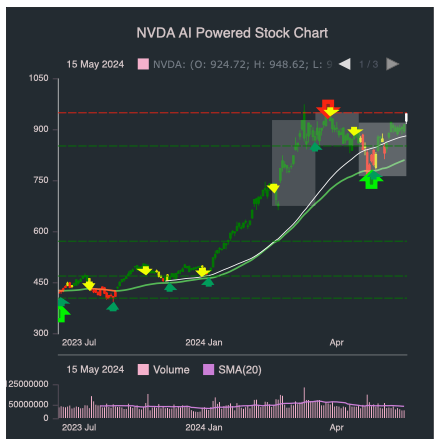The User Interface and User Experience of AI trading platforms for stock prediction/analysis are critical to ensuring usability and efficiency. They also contribute to overall satisfaction. Poorly designed interfaces can hinder decision-making, even if AI models behind it are reliable. Below are the top ten tips to evaluate the UI/UX.
1. The user-friendliness and the user-friendlyness of the product is evaluated
Navigation: Make sure that the platform is easy to use, using menus and buttons that are easy to grasp as well as workflows.
Learning curve: Find out how quickly users new to the platform can be able to use and comprehend the platform with no any extensive training.
Make sure that there is uniformity in patterns of design across different platforms (e.g. button styles or colour schemes, etc.).).
2. Look for customizability
Dashboard customization: Check whether users are able to customize dashboards to display relevant data, charts, and metrics.
Layout flexibility is crucial It is important to be able to rearrange and resize charts as well as widgets and tables.
Themes and preferences. Find out whether there are any dark or light settings, or any other preferences for visuals.
3. Visualize data using the Assess Tool
Quality of the chart - Make sure that the website offers high-resolution interactive charts (e.g. line charts and candlestick charts) that include panning, zooming, and other functions.
Visual clarity Make sure to ensure that the data is clearly presented that includes labels, legends and tips-offs.
Real-time updates: Check if visualizations are updated in real-time to reflect market changes.
4. Speed and Test Responsiveness
Loading Time: Make sure that your platform loads quickly even when you're managing large amounts of data.
Real-time Performance: Determine whether the platform is able to process data feeds with no delays.
Cross-device compatibility : Check if your device is compatible with the platform (desktops mobiles, tablets, desktops).
5. Assess accessibility
Mobile app accessibility: See if the platform offers an app for mobile devices that has full functionality for on-the-go trading.
Keyboard shortcuts. Make sure that your platform is compatible with keyboard shortcuts.
Accessibility features: Determine if the platform is compliant with accessibility standards (e.g. screen reader support, high-contrast modes).
6. Test Search and Filter functionality
Search functionality: Make sure that your platform permits you to search quickly for indexes, stocks and other investments.
Advanced filters: Find out the existence of filters that can be applied to the results.
Saved search: Verify whether the platform allows users save frequently used searches and filters.
7. Look for Alerts or Notifications
Customizable alerts. Users are able to create alarms based on certain conditions (e.g. prices thresholds, surges in volume).
Notification delivery: Verify that alerts are sent via multiple channels, e.g. SMS, emails, or in-app notifications.
Check the alerts' time-to-date and accuracy.
8. Integrating Other Software
Broker integration: Ensure that the platform is integrated seamlessly to your broker account to facilitate trade execution.
API access Find out whether APIs are accessible to advanced users who want to develop customized workflows or other tools.
Third-party interfaces: Make sure you know if the platform offers integrations with third-party tools (e.g. Excel or Google Sheets) and trading robots.
9. Assessment Help and Support Features
Tutorials for onboarding: Find out whether the platform has tutorials or walkthroughs for new users.
Help center: Make sure the platform provides a comprehensive knowledge base or help center.
Customer support: Find out if there is a responsive customer service (e.g. chat on the internet, email, or phone).
10. Test The Overall Satisfaction of Users
User feedback: Review and testimonials of research conducted to determine the overall satisfaction level of UI/UX.
Trial period - Test the platform with a no-cost trial to test how it works.
Check the platform's error handling.
Bonus Tips:
Aesthetics. While practical design is essential but a visually appealing design can boost user satisfaction.
Testing the performance of the platform under extreme stress to ensure that it's flexible and stable in times of high volatility.
Community and forums Forums and community: Find out whether the platform provides an online community or forum that allows users to discuss tips and feedback.
These tips will help you examine the interface for users and user experience of AI trading platforms that forecast or analyze the prices of stocks. You can make sure they're efficient, in line to your specific trading needs and are user-friendly. A great UI/UX will enhance your ability make informed decisions and execute trades efficiently. Read the top rated using ai to trade stocks recommendations for site examples including AI stock trading app, best ai trading software, ai for stock trading, market ai, AI stock, ai for stock predictions, ai trading tools, ai trade, investment ai, incite and more.

Top 10 Tips For Assessing The Risk Management Of Stock Trading Platforms That Use Ai
Any AI platform for analyzing or predicting stocks must include risk management, which is essential for protecting your investment and limiting losses. A platform that has robust tools for risk management can aid in the navigating of volatile markets and allow you to make educated decisions. Here are ten top suggestions to help you analyze the risk management capabilities of these platforms.
1. Examining Stop-Loss or Take Profit Features
Customizable Levels: Ensure that the platform allows you to define your own stop-loss levels as well as goals for taking profits in your trades or strategies.
Examine the platform to determine whether it is compatible with trailing stopped which adjusts automatically in the event that the market changes towards you.
Stop-loss guarantee: Check to whether the platform offers stop-loss guarantee, which will guarantee that your account will be closed at a specific price even in volatile markets.
2. Measure Positions Tools
Fixed amount. Be sure to can define your position sizes by the fixed dollar amount.
Percentage portfolio: Determine whether the risk is manageable in a proportional way by setting your positions according to centage of your overall portfolio.
Risk-reward ratio: Check if the platform supports setting risk-reward ratios for individual strategies or trades.
3. Make sure you are using Diversification Aid
Multi-asset trading : Make sure the platform allows traders to trade across various asset classes, such as ETFs, stocks, and options. This can help you diversify your portfolio.
Sector allocation: Determine whether your platform provides tools for monitoring and managing sector exposure.
Geographic diversification - Check that the platform supports the ability to trade on markets across the world. This will help diversify geographical risk.
4. Evaluation of Leverage and Margin controls
Margin requirements. Be sure to know the margin requirements before trading.
Be sure to check for limits on leverage. You can utilize this option to manage your risk exposure.
Margin calls: Verify if the platform provides regular notifications on margin calls to prevent account liquidation.
5. Evaluation of Risk Analytics and Reporting
Risk metrics - Ensure that your platform has important risk indicators like the Sharpe ratio (or Value at Risk (VaR)), or drawdown (or value of the portfolio).
Scenario analysis: Check whether the platform permits you to simulate various market scenarios in order to evaluate potential risks.
Performance reports: Check if the platform provides complete performance reports, including risk-adjusted returns.
6. Check for Real-Time Risk Monitoring
Portfolio monitoring: Ensure that the platform offers real-time monitoring of the risk exposure to your portfolio.
Notifications and alerts. Find out if the platform provides real-time notifications of risk-related events.
Risk dashboards: Find out whether the platform provides customizable risk dashboards for a comprehensive view of your risk profile.
7. Testing of Backtesting and Stress Evaluation
Stress testing: Check that the platform permits you to stress-test your strategies or portfolios during extreme market conditions.
Backtesting - See the platform you use allows you to backtest your strategies using previous information. This is a great method to gauge the risk and evaluate performance.
Monte Carlo Simulations: Check whether the platform uses Monte Carlo simulations in order to analyze and predict a range possible results.
8. Evaluation of Compliance with Risk Management Regulations
Ensure that the platform meets the requirements of regulatory compliance (e.g. MiFID II regulations in Europe, Reg T regulations in the U.S.).
The best execution: Make sure that the platform adheres with the best execution practices. Trades are executed at the most affordable price possible to minimize loss.
Transparency: Find out whether the platform has clear and transparent risk disclosures.
9. Verify that the risk parameters are controlled by the user.
Custom risk rules: Make sure that the platform permits you to set up your own risk management rules (e.g., maximum daily loss, maximum size of the position).
Automated risk controls: Check whether the platform can automatically enforce rules for risk management in accordance with the parameters you've set.
Manual overrides: Make sure to check whether the platform permits manual overrides of automated risk controls in case of emergency.
Study Case Studies, User Feedback, and Case Studies
User reviews: Examine reviews from customers to evaluate the platform's effectiveness at managing risk.
Case studies: Search for case studies or testimonials which highlight the platform's capabilities in risk management.
Community forums: Check whether the platform has an active user community where traders share risk management tips and strategies.
Bonus Tips
Trial period: Make use of a free demo or trial to experience the capabilities of the platform for managing risk in real-world scenarios.
Support for customers: Ensure whether the platform offers robust support in relation to issues or questions relating to risk management.
Check for educational sources.
Follow these tips to assess the risk management capabilities of AI trading platforms which predict and analyze the prices of stocks. Choose a platform with a high degree of risk management, and you will limit your losses. The use of robust risk management tools is vital to navigate the volatile markets and achieving long-term trading success. Follow the recommended inciteai.com AI stock app for site recommendations including best ai for stock trading, stocks ai, free AI stock picker, best ai penny stocks, how to use ai for copyright trading, chart analysis ai, best AI stock prediction, best ai penny stocks, stock predictor, free AI stock picker and more.
